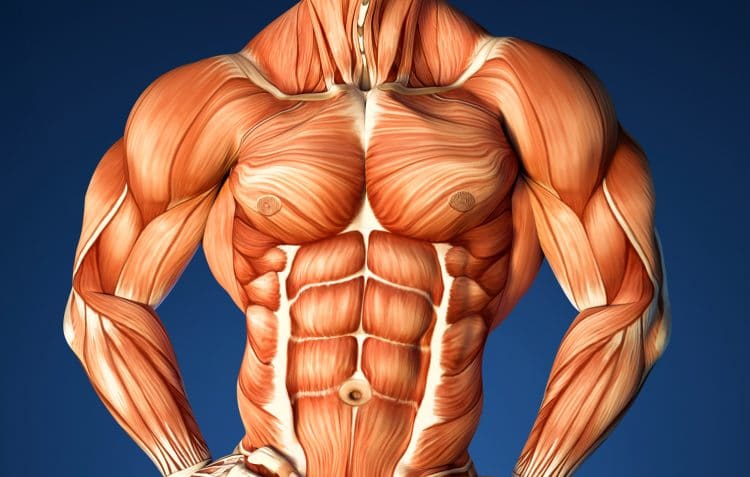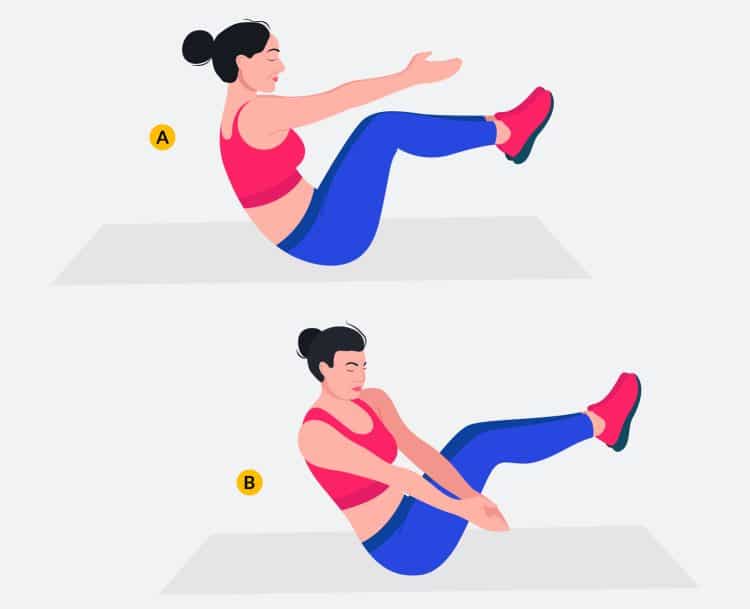Whatever you are training for, you need to work on your abs. It doesn’t matter if you’re a bodybuilder who wants a six-pack, a powerlifter trying to increase your deadlift or someone who just dreams of a flatter, firmer stomach. You NEED to include abs exercises in your workouts.
But, here’s the thing; a lot of people leave their abs training to the end of their workout and don’t spend much time training this vital group of muscles. This makes a lot of sense because they’re probably tired after all the other exercises they’ve just done. Abs training becomes something of an afterthought.
One way around this problem is to work your abs at home when you’ve got more time and energy.
The good news is that you don’t even need a lot of equipment to get a good home abs workout; just an exercise mat or even a folded towel will suffice.
Mason twists are a great at-home abs exercise, and in this guide, we reveal how to do them, their benefits, and the best variations and alternatives.
Mason Twists – Muscles Worked
The Mason twist is a core exercise and, as such, work the following muscles:

- Rectus abdominis – located on the front of your stomach, the rectus abdominis or abs for short is probably the muscle you’ll feel working most during Mason twists. Your abs will have to work hard to keep you in the proper position. The main functions of your abs are flexion and lateral flexion of your spine.
- Obliques – your obliques are basically your waist muscles. There are two sets of oblique muscles, internal and external, and both work together to rotate and laterally flex your spine.
- Transverse abdominis – known as the TVA for short, the transverse abdominus encircles your waist like a natural weightlifting belt and provides your spine with support. While you can’t see your TVA, it’s definitely working hard during Mason twists.
- Hip flexors and rectus femoris – made up of two muscles, the iliacus and psoas major, the hip flexors hold your legs up during Mason twists. The Rectus femoris (which is one of your quadriceps) works with your hip flexors and is also very active during this exercise.
How to Do Mason Twists

Get the most from mason twists while keeping your injury risk to a minimum by following these step-by-step instructions:
- Sit on the floor with your legs bent. Lean back and lift your feet a few inches off the floor so you are balancing on your butt.
- Clasp your hands together in front of your chest.
- Without lowering your legs, turn your shoulders and touch your hands on the floor just outside your left hip.
- Switch sides and repeat.
- The faster you go, the more unstable you’ll be, and the more challenging this exercise becomes.
Mason Twists Benefits
Mason twists are a useful abs exercise with several notable benefits:
- Ideal for beginners – Mason twists are straightforward, easy to learn and master, and not too difficult. In short, they are an excellent exercise for beginners.
- Anywhere, anytime – you don’t need any equipment to do Mason twists. Even an exercise mat is optional because you’ll be sitting on your butt, and even if you are very lean, that should still be enough padding for a comfortable workout.
- Good for circuit training and HIIT – with no equipment, this exercise is straightforward to do, and it takes next to no time to get into the proper starting position. As such, it’s perfect for fast-moving workouts like high-intensity interval training.
- A comprehensive abs workout – Mason twists work your abs, TVA, and obliques simultaneously, providing a time-efficient, total abs workout.
- Good for your balance – one of the most challenging parts of this exercise is balancing on your butt and keeping your feet off the ground. Exercises that challenge your balance are useful as balance often diminishes with age, leading to an increased risk of falls. Balance is also important in sports.
Mason Twists Drawbacks
While Mason twists are a beneficial abs exercise, there are a few drawbacks to consider too:
- Limited overload – the difficulty of this exercise is governed mainly by the weight of your legs. The only effective way to make this exercise harder is to do more reps. High rep sets of abs exercises are not very time-efficient and don’t do much for muscle strength, either.
- Back strain – your hip flexors attach onto your lumbar spine and can pull your lower back into an extended position unless you brace your core correctly. As such, some people may find that Mason twists cause back pain.
7 Mason Twist Variations and Alternatives
While Mason twists are a popular and effective exercise, it won’t take long for them to lose some of their potency if you do them too often. Also, if they aren’t challenging enough for you, they won’t be as rewarding. Keep your core workouts fresh and productive with these Mason twist variations and alternatives.
1. Weighted Mason twists

If bodyweight Mason twists aren’t challenging enough for you, try the weighted variation. Simply hold a dumbbell or medicine ball in your hands and touch it down alternately to your left and right side. A little weight goes a long way with Mason twists, so don’t go too heavy too soon.
2. Alternating V-ups
While this exercise doesn’t look a whole lot like Mason twists, it works all of the same muscles. It’s a little more challenging, and the fast pace and large movements mean that it will also raise your heart and breathing rate, making it an ideal exercise for HIIT.
How to do it:
- Lie on your back with your legs straight and arms by your sides. Brace your abs.
- Sit up, lift one leg, and reach up for your toes with your opposite arm. Increase oblique recruitment by reaching past the outside of your foot.
- Lie back down and repeat on the opposite side.
- Continue alternating sides for the duration of your set.
3. T-Rotation
We’re the first to admit that this exercise looks nothing like Mason twists, and yet it works the same muscles as well as your arms and shoulders. Also, just like Mason twists, this exercise requires no equipment, so you can do it anywhere and anytime.
How to do it:
- Adopt the push-up position, also known as the high plank. Your arms should be straight, and your shoulders, hips, knees, and feet should form a line. Brace your abs.
- Shift your weight over onto one hand, turn your shoulders and hips, and reach up to the ceiling with your free hand to form a T-shape.
- Return to the high plank position and repeat on the opposite side.
- Keep your core braced throughout.
4. Cable Russian twist
If you’ve got a stability ball and a cable machine, you’ll undoubtedly enjoy this Mason twist alternative. Because the weight is variable, you can make this exercise as hard or as easy as you wish. It really emphasizes your obliques, and while this move IS unusual, you’ll soon come to realize just how effective it is when you try it for yourself.
Learn how to do this cable russian twists exercise here.
5. Single-arm dumbbell bench press
No, you haven’t accidentally clicked on a chest training article! In fact, single-arm dumbbell bench presses are a very effective abs and obliques exercise. That said, they do still work your chest, shoulders, and triceps, which makes them a very time-efficient compound exercise.
How to do it:
- Lie on a flat exercise bench with a dumbbell in one hand. Place your feet firmly on the floor and brace your abs. Press the weight up and hold it over your shoulder, arm vertical, and palm facing down toward your legs.
- Without allowing your shoulders or hips to rotate, bend your arm and lower the dumbbell down to your shoulder.
- Press it back up and repeat.
- At the end of your set, swap arms and do the same number of reps on the opposite side.
- You can also do this exercise using a kettlebell or while lying on the floor if you don’t have a workout bench.
6. Offset kettlebell squat
This is another exercise that looks nothing like a Mason twist but still works the same muscles. The offset kettlebell squat will increase the strength of your legs while also developing your abs and obliques. It’s a very functional, time-efficient exercise.
How to do it:
- Lift and hold one kettlebell at shoulder height, so the weight rests against the back of your forearm. Brace your abs and stand with your feet about shoulder-width apart, toes turned slightly outward.
- Push your hips back, bend your legs, and squat down until your thighs are parallel to the floor. Do not round your lower back or lean sideways.
- Stand back up and repeat.
- No kettlebell? You can also do this exercise using a single dumbbell.
7. Bodyweight floor wipers
This exercise is a whole lot harder than Mason twists, but if you are ready for a challenge, this is the move for you. The good news is that you don’t need any equipment to do this exercise, making it ideal for home workouts.
How to do it:
- Lie on the floor with your legs straight and arms extended out to form a T-shape. Brace your abs and raise your legs, so they’re vertical.
- Without bending your knees, rotate your hips and lower your feet down toward your outstretched hand. Do not touch the floor.
- Raise your legs, return to your starting position, and then repeat on the opposite side.
- Continue alternating sides for the prescribed number of reps.
- Make this exercise easier by bending your knees to shorten the lever.
Related: Floor Wipers Guide
Mason Twist – Wrapping Up
Fitness experts love to argue about the best way to train your abs. Some say that exercises like squats and deadlifts are the best solution, while others believe things like cable crunches and hanging leg raises are superior. The reality is that the best training methods are usually the ones you find most convenient and that often means bodyweight exercises that you can do anywhere and anytime – like Mason twists.
If it’s hard to find the time to train your abs at the gym, start working them at home instead. You don’t need much (if any) equipment, and, initially, at least, your bodyweight will provide your muscles with all the resistance they need to get stronger. Make Mason twists part of your abs workouts.


